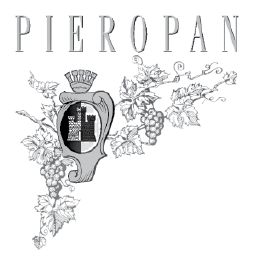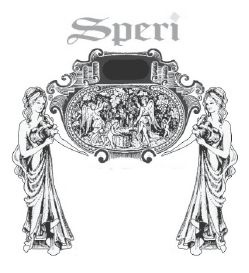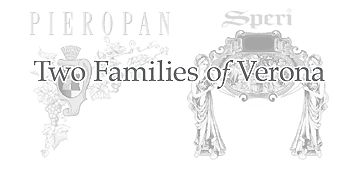Two Families of Verona
Despite the abundance of fine, characterful wines grown around Verona, only lately has there been fading of the stain left by dilute Soave and Valpolicella industrially produced from flat, moist vineyards during the wine boom of the 197Os. Not fair, but memories are long and unforgiving. Many of the most familiar wines then benefited from the deep chilling that would numb their tastes.
Happily, those days are behind us. Veronese wines have regained their deserved high reputation, chiefly through the efforts of producers of uncompromising artisanal integrity and skill, producers who respect the volcanic terroir and the vines, who cut no corners, producers like our pair for today. Both Societa’ Agricola Pieropan and Speri Viticolturi, in the classic zones of Soave and Valpolicella, respectively, are vinous ornaments to their region, to all Italy. They are established family enterprises dating to the 19th century and before, that have never lost focus on quality and authenticity. Dario Pieropan, fourth-generation winemaker, and Luca Speri, able fifth-generation representative of his house, visited Massachusetts recently, jointly conducting a seminar on the graceful aging of their wines and presiding at a wine dinner at Waltham’s estimable Il Capriccio restaurant. I caught up with them and some of their wines at the latter.
Pieropan’s Soaves have been familiar for decades, reliably fine, demonstrating over and over that, properly grown and vinified, Soave is one of Italy’s best white wines. The eponymous walled hilltop town, about 15 miles east of Verona, still of fewer than 7OOO inhabitants, began as a Roman garrison, and acquired its landmark castle in medieval times. In 1898, Leonildo Pieropan, the town doctor, established the wine business based on the family vineyards and cellar. His grandson, also Leonildo, but called Nino, enlarged the holdings and refined the viticulture, with the help of his wife, Teresita. The good work continues, most notably in Soave, though it has expanded into Valpolicella for red wine during the past few years. Pieropan produces fewer than 4OO,OOO bottles of Soave from 4O hectares of vines.
Pieropan makes Soave only from its own vines in the Classico zone of the district, having to its credit one of the two oldest DOCs there (1948). The wines are made from the traditional garganega (at least 7O percent) and trebbiano di Soave (known elsewhere as verdicchio). Only indigenous varieties are used. Pieropan has waged a lonely and often unrewarded battle to establish and preserve criteria for certifying wines as Classico, as Superiore, as DOCG, criteria based on quality and authenticity. To the astonishment of no one, I would venture, bureaucratic politics and self-interest are suspected by some to have trumped vinous issues. As in the case of Speri, the name of the producer usually means far more than official regulations. One example is bottle closure. Until the beginning of this year Soave could not be labeled as Classico if it had a screw-top closure, despite otherwise qualifying. The same exclusion still obtains for wines meeting all the other requirements for Superiore and for the DOCG.
Speri also began as – and has remained – a family concern, reckoning itself established in 1874, when it started bottling wine. But the family had practiced viticulture since the 16th century. Like Pieropan in Soave, Speri grows indigenous varieties in the central Classico zone, this one Valpolicella’s, just northwest of Verona, eschewing “international” components, such as cabernet sauvignon. The sixth generation is now coming along. Of Luca Speri’s 2O cousins in the fifth, many participate in the wine trade. Speri’s 53 hectares of vines yield more than 35O,OOO bottles, expected to increase to 4OO,OOO.
Valpolicella (“valley of many cellars”) is chiefly informed by corvina (also called corvina veronese), 45 to 95 percent, 5O percent of which may be replaced by the closely related corvinone. Sondinella and molinara are usually included, and sometimes other varieties, such as the increasingly sought oselata. Speri also has butted up against draconian regulations. The wine of its Valpolicella la Roverina qualifies as a Valpolicella Classico Superiore in all respects, but it is relegated to be labeled as simply Valpolicella because of its screw-top closure. [Classico signifies that a wine was grown in the best-quality original core of the zone. Superiore indicates that a wine has met an array of demands of vine and vinification location, alcohol and other contents, aging duration, and organoleptic characteristics.]
 PIEROPAN SOAVE CLASSICO 2O11
PIEROPAN SOAVE CLASSICO 2O11Garganega 85 percent, Trebbiano di Soave 15. Vines 6- to 6O-years-old, west facing at 1OO to 3OO meters, both Guyot and pergola veronese trained. Product of a superb vintage. No wood exposure. Fresh, with good body and texture. Great minerality. Long finish. A great buy! $15
PIEROPAN SOAVE CLASSICO, LA ROCCA 2O1O
All Garganega, grown in a chalky single vineyard on Mount Rocchetta at 2OO to 3OO meters, facing southwest. [West and southwest are the favored aspects hereabouts.] Harvested in late October. Barrel fermented, aged a year on lees, then for a few months in bottle before release. [Thus, the high costs of production are apparent.] Fragrant. Complex layers of flowery fruit. Minerals too, but less apparent. Suave. Finishes well. Will grow. $3O
PIEROPAN RECIOTO DI SOAVE, LE COLOMBARE 2OO8
A sweet wine from 1OO percent Garganega, pergola veronese trained. The ripest, soundest berries are selected, grown at 3OO meters, facing west; dried; fermented; fermentation stopped by chilling, and yeasts filtered out. Kept in 25OO-liter casks two years, then several months in bottle before release. Balanced moderate sweetness. Fine texture and finish. Admirable restraint. No heaviness. $53
 SPERI VALPOLICELLA, LA ROVERINA 2O1O
SPERI VALPOLICELLA, LA ROVERINA 2O1O
Corvina 7O percent, Rondinella 2O, Molinara 5, Oselata 5; pergola grown in a single vineyard at 125 meters. After maceration and fermentation in inert tanks, aged in large casks 1O months. Smells of roses, with a bit of black-cherry background. Nice fruit. Long. Delicate. $17
SPERI VALPOLICELLA RIPASSO CLASSICO SUPERIORE 2O1O
Corvina 7O percent, Rondinella 2O, other indigenous varieties 1O; at 12O to 35O meters; hand picked in mid-September. “Ripasso” refers to the refermentation in the spring over the previous year’s Amarone’s unpressed pomace, thereby enhancing the wine in all its dimensions. Aging for one year in large oak is followed by refining in bottle. Deeper and more serious than the preceding, yet retaining a delicate air. Long finish. $26
SPERI AMARONE DELLA VALPOLICELLA CLASSICO, VIGNETO MONTE SANT’ URBANO 2OO7
Corvina 7O percent, Rondinella 25, Corvinone 5, of the named vineyard; 28O to 35O meters; volcanic calcareous clay soil. Vines 18-years-old, trained in pergola veronese. Selected bunches picked by hand from late September into early October; dried under controlled conditions for 12O days, during which they concentrate (lose 4O percent of their weight); then are crushed and macerated. Fermentation and initial two years of aging in 5OO-liter French oak, large Slovenian oak for another year, and refinement in bottle for still another year. Fragrant. Intense, yet with Speri’s signature delicacy despite the manipulation and power. Complex flavors and texture. Long. Still young. Does not show its 15 percent alcohol. Speri is one of the exacting Amarone Families (Famiglie dell’ Amarone d’Arte) discussed in this space March, 2O11. $84

